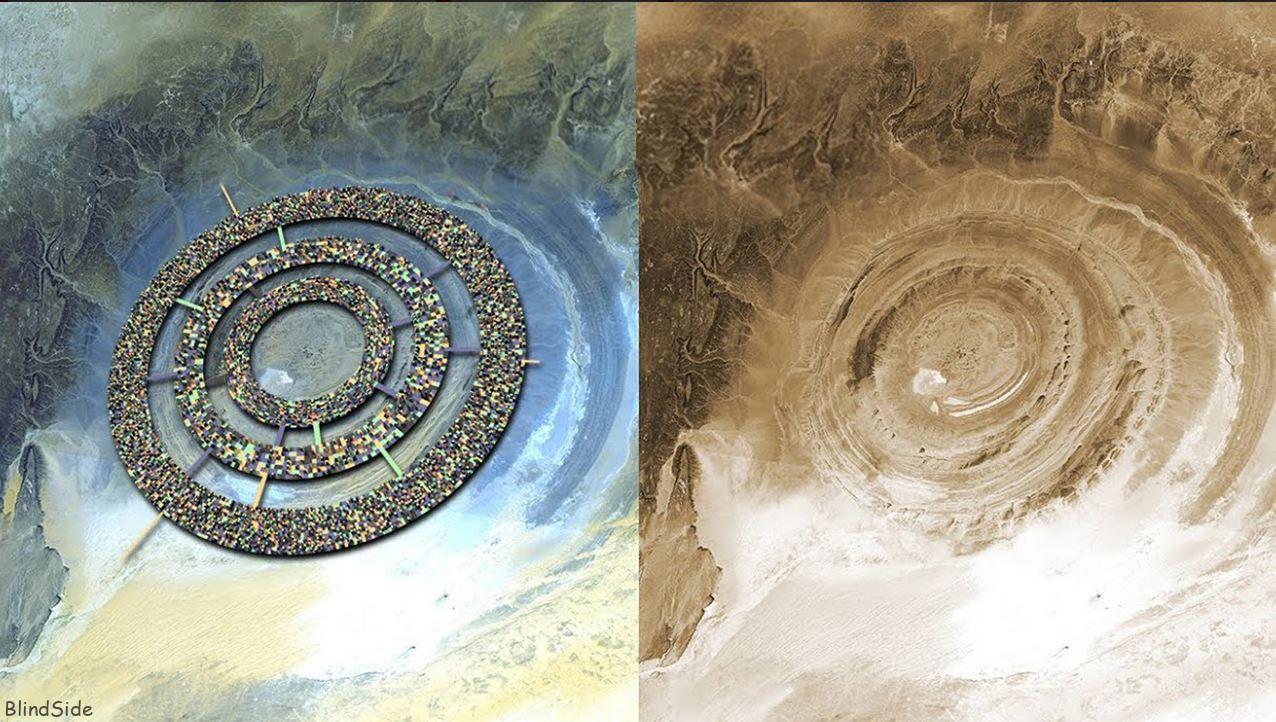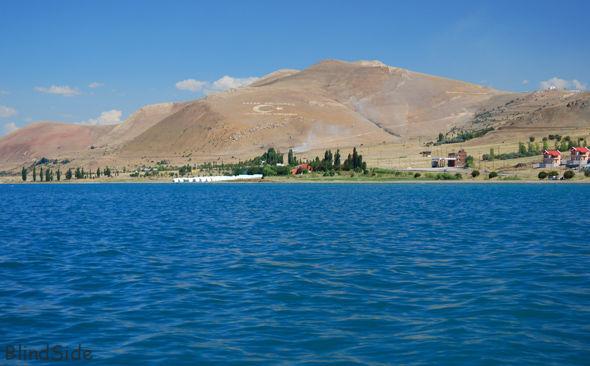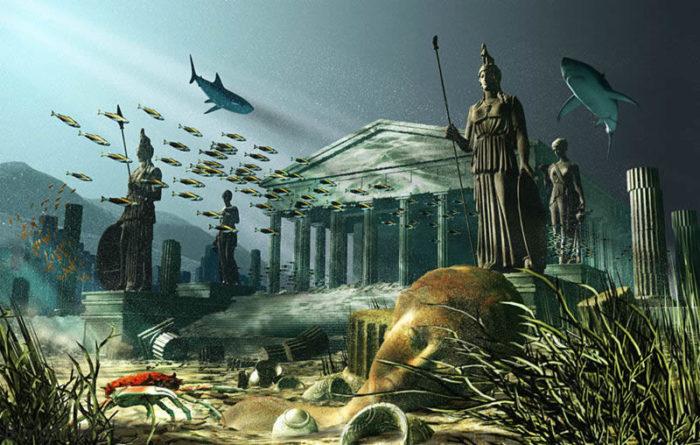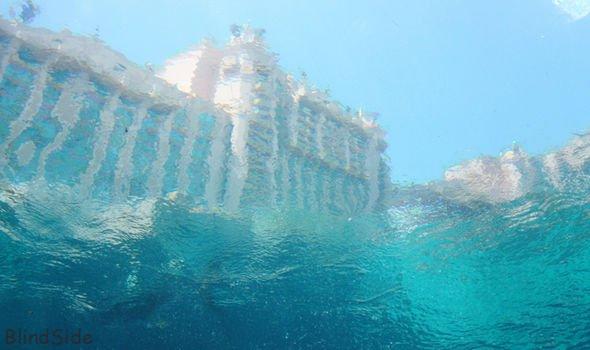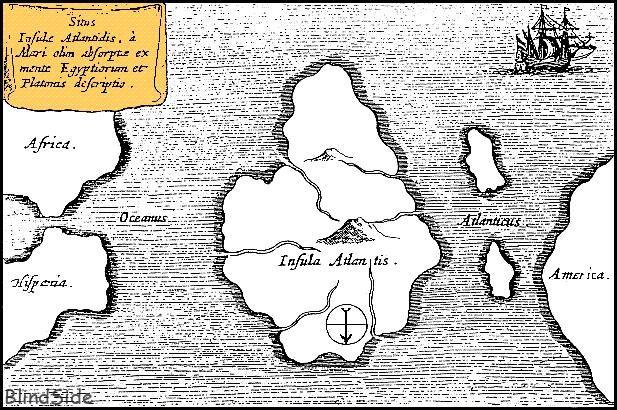We are here on the Blind Side, Legend has it that there was once a palatial kingdom in the middle of the Atlantic Ocean. A real city, ‘Atlantis’ is said to have disappeared following a catastrophic event. If this theory is true, where are the ruins? Are they in the Atlantic Ocean or somewhere else? From the geological circular feature visible from space, to the original lost kingdom of Atlantis, here are 15 Real Pieces of Evidence that Prove the Existence of Atlantis.
15. Blue eye of Africa, Mauritania
A prominent geological circular feature in the Sahara Desert, the Richat Structure, also known as the Eye of the Sahara or blue eye of Africa, was initially interpreted as an asteroid impact structure, due to its circular formation.
Measuring nearly 50 kilometers across and visible from space, it is now argued to be the remains of a highly symmetrical and deeply eroded geologic dome that collapsed.
Greek philosopher Plato believed Atlantis was circular and divided into circles of land and water, creating an impossible barrier of mud when it was sunk by an earthquake.
A mountain was said to shelter the city by North and a great plain to the South, with pillars lying to the front of the Island. These were the ‘Pillars of Hercules’.

An earthen structure of unknown origin, located on the north west coast of Africa, the Richat Structure was created about 100 million years ago. It is very large, with very similar measurements to those Plato suggests Atlantis was.
He described the nearby mountains as representatives of the Gods and located to the north, the exact location of the Eye’s mountains. Plato also said the sea was to the south and the desert bordered the area.
And when you look at the satellite images of the Eye, you can see the desert, the river and water lines that he mentions, clearly visible throughout the landscape.
14. Tantalis, Turkey
The original lost Kingdom of Atlantis has been found, according to British archaeologist Peter James.
The London specialist in Near Eastern ancient history, believes the city is not in the middle of the Atlantic Ocean, as previously thought, but in the interior of Turkey.
Using six classical sources, Mr James reconstructed a quasi-historical legend on which the story of Atlantis was original based.
The legend suggests that Atlantis was in fact a real city in the west of Asia Minor called Tantalis, and it was destroyed by an earthquake and flooding after 1400 B.C.
Preliminary findings of the suggested location found a now dried up lake that Mr James believes once covered the site.
After piecing together evidence from works by classical authors, he concluded that Atlas, the key figure in the Atlantis legend, was inspired by a semi-legendary Anatolian king.
The king, Tantalus is believed to have ruled over a doomed city called Zippasla or Sipylus, but now known as Tantalis.
Tantalus is said to have controlled an empire that stretched from the Aegean Sea to central Anatolia. It may have also included sections of both Cyprus and Israel before it was absorbed about 50 years later into Hittite territory.
This legend bears a striking resemblance to the Atlantis story, with just one significant difference, its location.
13. The southern coast of Spain

A team of English historians believe they have found the location of the lost city of Atlantis.
Using satellite imagery, the experts say that ancient Spanish ruins may hold the key to solving one of the world’s most intriguing mysteries.
The researchers believe the city was built by a mysterious ancient people, known as the Atlanteans, with their pictures showing remnants of a harbor wall measuring five-and-a-half miles long in southern Spain.
This wall was mentioned by Plato, who wrote about the wall, saying it was 50 stadia long, making it five-and-a-half miles on today’s measurement scale.
Historians believe the area inside the Doñana National Park, Andalucia was once a vast inland sea. Maritime historian Tim Akers, head of research at private satellite imaging firm Merlin Burrows, collected samples for scientific testing, and sent them to a lab in Modena, Italy that was able to test ancient Roman finds.
The results of the laboratory analysis of patina found at the Spanish site, showed it was an ancient combination of metals, described in detail by Plato as being the building material used to construct the kingdom of Atlantis.
Merlin Burrows aren’t the first to lay claim to the theory that Atlantis is in southern Spain, and they probably won’t be the last, but until solid evidence surfaces, the legend of the city’s existence will live on.
12. Akrotiri, Santorini
Plato’s description of how the mythological island of Atlantis was destroyed has strong similarities to the story of the Minoan Akrotiri, that also disappeared without a trace in the 17th century.
Previously located in Santorini, the settlement of Akrotiri’s intriguing history dates back a staggering 7,000 years.
From humble beginnings, the small fishing village grew to become an important trading post, a busy little city with extensive sewage systems, paved streets and many stone buildings.
However, the eruption of Mount Theba, followed by a powerful tsunami, put an end to the city, leaving it in tatters and completely uninhabitable.
The city’s connection to Atlantis was conveyed to Solon during one of his trips to Egypt.
Egyptian priests believed that Atlanteans once had divine powers, however these were gradually lost. In order to gain back power, at least of the human kind, they decided to travel around the Mediterranean conquering other prosperous islands, until they were eventually defeated by the Athenians.
The Gods, angry at their behavior, are believed to have destroyed Atlantis as punishment.
11. Doggerland

Forming part of the North Sea, Doggerland once stretched all the way from the east coast of England and Scotland to Denmark. Left dry for several thousand years, following the end of the last ice age, Doggerland was home to a thriving Mesolitic population.
Described as ‘the true heart of Europe’ by geochemist Richard Bates, it struggled for several millennia against rising sea levels and eventually succumbed following a sudden catastrophe between 6200 B.C. and 5500 B.C.
With suggestions its destruction was connected to the Störegga landslide, Doggerland could also be considered as another possible location for Plato’s Atlantis.
This theory was given further weight in 2012 when at a meeting of the British Royal Society, a book published by Frenchman, Jean Deruelle was discussed. Published in 1999, the book “L’Atlantide des Mégalithes,” presented a strong case for the notoriously elusive ‘Great Plain’ of Atlantis being situated on the now submerged land in the North Sea.
Although surveyed many times, researchers recently came across a fossilized forest below the waves at Doggerland, renewing hope of one day finding the long-lost human settlement.
10. Morocco
For centuries experts have had us believe that the lost city of Atlantis ruins are to be found somewhere under the sea, but could this theory be false? Are they on land somewhere?
Michael Hubner, a German computer expert believes the remains of Atlantis are ‘hiding in plain sight’ in south west Morocco.
He said a tsunami had overwhelmed the ancient metropolis, flattening it 2,000 years ago.
Using clues left by Plato, Hubner has calculated GPS coordinates of the lost city and believes the remains may have been left undiscovered, near the coast of Marrakesh.
The site had many of the 51 clues, left by Plato, including being surrounded by concentric circles.
A far cry from previous ideas about Atlantis, Hubner is not alone in his beliefs, with other enthusiastic Atlantis seekers utilizing clues from obscure Babylonian myths or unpublished documents from the Vatican’s secret archives to pinpoint its supposed location.
9. Crete
Some scholars place Atlantis at Crete. They believe it collapsed at the hands of a volcanic eruption in the middle of the second millennium B.C.
Was Plato’s theory inspired by an actual event in his own time, the earthquake of 373 B.C that bought the Greek city of Helike crashing into the sea?
There are more mythological tales, legends and real-life events surrounding this mysterious island, than just about anywhere else in the world, but are its origins in Crete?
A beautiful island, Crete is the fifth largest in the Mediterranean, and home to the ancient village of Palaikastro, where broken pottery, building materials, and even cattle bones have been found washed up along its eroding coastline.
Soil scientist Hendrik Bruins and archaeologist Sandy McGillivray examined layers of soil and discovered they contained micro-organisms that can only be found in soil on the ocean floor. To have reached the coastline, a powerful tsunami must have been responsible.
The presence of Theran pumice provided additional proof that a volcano caused the tsunami, and carbon dating on a cow bone confirms it was deposited there around 1600 B.C., the same time that Thera erupted.
We may never know for sure if Crete was Atlantis, however this theory may explain the downfall of Europe’s first great civilization.
8. The Atlantic ocean, Canary Islands
A rock formation ‘hiding’ at the bottom of the Atlantic Ocean, has archaeologists guessing its origins, with many believing it is the remains of Atlantis.
Having broken away from a group of islands 10,000 years ago, a bombshell documentary has claimed it is the much talked about mythical city.
Historians believe the Canary Islands may have once been linked together, with the much larger piece of land sinking below the water as a result of rising sea levels and a huge earthquake.
The 2018 series of Amazon Prime’s “Proof That Left Historian’s Speechless” documentary revealed that Atlantis’ remains may well be still hiding below the Atlantic Sea, however, the strong Gulf Stream makes the waters too treacherous to check.
There are several facts about the island of Atlantis that are very rarely debated. It was said to probably be smaller than Southern Italy, was somewhere in the Atlantic Ocean, and close enough that ships were able to pass the Straits of Gibraltar and enter the Mediterranean.
If Plato’s description is to be believed, then the volcanic Canary Islands fit a great deal of these descriptors, including its volcanic properties, the fact it was once an ancient trade route to the Americas, and evidence of ruins.
7. Caribbean

In 2009, a group of ‘undersea archaeologists’ raised several eyebrows when they presented grainy images of a city-like formation at the bottom of the Caribbean.
Although sceptics refrained from debunking them entirely, the scientists haven’t helped their case, refusing to identify themselves.
With the legitimacy of their claims up in the air, the scientists insist their snaps show a pattern on the seabed that could be the ruins of a city that pre-date Egypt’s pyramids, which appeared after 2600B.C.
Following the publication of this information in the Herald de Paris in 2009, architectural historian and archaeologist Jes Alexander was asked for his opinion on the supposed find.
He believes that Plato’s description of Atlantis matches the area of the Caribbean Basin, depicted in the grainy images taken by the undersea archaeologists.
In fact, he went so far as admitting that no other place on earth matches Plato’s description than the Caribbean Basin.
With a bit of luck, the historical record may soon be set straight.
6. Malta
Experts believe that Malta could be the Lost City of Atlantis, and Plato’s writings on the mysterious island could inadvertently back up this theory.
He believed that a tsunami was behind the eradication of the ancient city, one that happened at the same time Malta was struck by an unknown catastrophe.
Evidence also points to the fact that Malta and its little sister islands once formed part of Europe and/or Africa. Having been struck by some sort of natural disaster, the islands were formed.
This fact was partially proven in 2013, when University of Malta marine scientists discovered that 20,000 years ago, the Maltese Islands were connected to Sicily via land bridge.
The islands were much larger back then, with proof in the fossils of elephants, bears, reindeer, hippopotamus and more, found in caves around the island.
Malta is now so small, there is no way it could possibly provide large animals with enough food and water; therefore, it must have been larger at some point.
Finally, Malta’s ancient structures date back over 9,000 years ago, with archaeologists stating they are the oldest ruins in the world, most scattered around its islands.
5. Spartel Island

Yet another candidate for the lost city was published in a Geology paper, written by Marc-Andre Gutscher in 2005. The paper points to the submerged island of Spartel, west of the Straits of Gibraltar, as being the location of the lost ancient city.
Spartel is said to have plunged 60 meters beneath the surface in the Gulf of Cadiz, at the end of the most recent ice age.
Melting glaciers had caused the sea level to rise and geological evidence shows that a large earthquake and a tsunami hit the same island some 12,000 years ago.
Both the timing and location are outlined in Plato’s writings.
Using sea-level measurements, Spartel estimated the island to be less than 500 meters in diameter, having been reduced to wave-swept rocky inlets. This fact alone, would make it impossibly small for a sophisticated city.
Gutscher believes the island may have sunk further since those times, with eight earthquakes happening in the area since Atlantis is believed to have sunk. Each earthquake may have caused the sea floor to drop several meters and whittled the island away. Spartel could have been 40 meters higher 12,000 years ago and measured more than two kilometers.
A promising candidate, Gutscher’s study provides further support for Plato’s writings, but hard proof is yet to be found.
4. Cyprus
A team of American ocean researchers were convinced they had found evidence of the existence of the lost kingdom of Atlantis in 2004.
Having created images of the seabed a mile below the surface of the Mediterranean, they believe the island is located off the coast of Cyprus.
The researchers, led by Robert Sarmast, spent six days at sea surveying the area, using sonar imaging.
They located what appeared to be two straight walls, each about a mile long, alongside a flat-topped hill. The structures looked to be man-made and there was also evidence of two streams flowing from springs on the summit.
According to Sarmast, the way in which Atlantis slowly sank is one of the most vital clues in determining its location, with very few locations able to meet these specific demands.
He doesn’t believe an island in the Atlantic Ocean would slowly sink after an earthquake, tsunami or both, identifying the Mediterranean Sea, specifically the area immediately to the south east of Cyprus, as the location for Atlantis.
3. The Black Sea hypothesis
Contrary to the earthquake and/or tsunami hypothesis, William Ryan and Walter Pitman (Ryan et al., 1997; Ryan and Pitman, 1998) suggested that the city of Atlantis was lost following a catastrophic flood about 7150 yr B.P. They proposed that the Black Sea was flooded by marine waters from the Mediterranean.
The flood was the result of a dam breach in the Bosporus in north western Turkey. Prior to the breach, the Black Sea was 150 meters below its present level and following it, water rushed through at speeds of up to 90 kilometers per hour.
If this was what happened, it would have taken 787 days to fill the Black Sea from its original depth to 15 meters below its present level.
As a result of this flooding, Ryan and Pitman believe there was a mass exodus of people inhabiting the area bordering the Black Sea.
The theory was severely challenged by international scientists, however, Bulgarian Marine-Geologists Petko Dimitrov and Dimitar Dimitrov believe the theory is correct, based on the examination of sediments, rather than mollusks.
In 2004, the Ryan and Pitman published the results of their studies saying that until 5500 B.C., the Black Sea was a smaller freshwater lake.
They proposed that Atlantis was initially a settlement on the edge of that lake and when the flood came through, the city was destroyed.
2. Sardinia
Greek philosopher Plato placed Atlantis beyond the pillars of Hercules, the strait between Sicily and Tunisia, however writer and journalist Serio Frau believes its remains might lie in Sardinia.
One of the founders of Italian daily La Repubblica, Frau has been investigating the subject of the lost city for more than a decade.
Frau visited Sardinia in 2015, where he and a dozen or so Italian scientists, including an archaeologist, archivist, geophysicist and an expert on tidal waves, viewed the island on land and by air. What they found resembled ‘a marine Pompeii submerged by mud’.
The team found a variety of ceramics, lamps, sharpening stones, meal implements, knives, chisels and arrow tips, all seemingly dumped as if their original owners were in a hurry to leave.
Although considered remarkable, these archaeological finds attracted very little attention until the mid-20th century, however, we now know that the island was home to many megalithic fortresses with a central tower, dating back to the middle of the bronze age between the 16th and 12th century B.C, many of which have vanished under piles of earth.
Those on high ground have been spared, with registered structure numbers having risen from 9,000 to 20,000 in the past 20 years.
What catastrophe, circa 1175BC, plunged Sardinia into a ‘dark age’? Was it a tidal wave? If so, it might explain the large Campidano plain, which cuts across the southern part of the island from Cagliari to the Phoenician port of Tharros, on the west coast.
Geophysicist professor Tinti believes a falling comet may have been responsible, striking the sea at a speed of 20 kilometers a second and creating a wave, so large, it obliterated the island
1 Atlantis: Plato’s invention
If much of what Greek philosopher Plato says is true, then we are to believe that the founders of Atlantis were half god and half human.
They are said to have created a highly desirable society for civilization, made up of islands separated by wide moats and linked by canal. These islands contained an abundance of precious treasures and rare, exotic wildlife.
According to Plato, Atlantis existed about 9,000 years before his time, however few, if any, scientists think it existed at all.
Although not entirely convinced of Plato’s theory, ocean explorer Robert Ballard, the National Geographic explorer-in-residence says, the legend of Atlantis is a ‘logical’ one.
With catastrophic floods and volcanoes common throughout history, Plato’s story mirrors that of the massive earthquake that devastated the island of Santorini about 3,600 years ago.
The Minoans who lived there disappeared overnight, however Ballard doesn’t believe Santorini was Atlantis, as the timing is all wrong.
Bullard believes that Plato made up Atlantis as a clever plot for his two dialogues, the ‘Timaeus’ and the ‘Critias’, both written about 360 B.C.
He says there are no other records of the mysterious island anywhere, and with so many Greek texts, Ballard finds it unusual that such a remarkable place has never been mentioned, even in passing.
And with the addition, omission, or misinterpretation of Plato’s theories about Atlantis, almost any proposed location can be made to fit within his descriptors.
There is just simply no evidence, prior to Plato writing about it.
With so many theories surrounding the existence of the lost city of Atlantis, it’s difficult to know who to believe. Is it situated in the Atlantic Ocean, Turkey, perhaps even the Mediterranean Sea or the Caribbean? Did it even exist? Also, check out our other cool stuff showing up on screen right now. See you next time!
